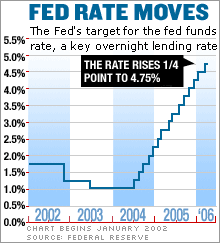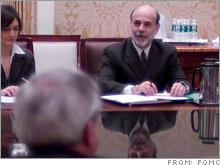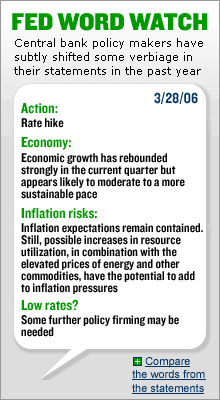Fed raises rates in Bernanke's first meeting
Central bank boosts rates a quarter-point to 4.75%; new chief Bernanke says more rate hikes may be needed.
NEW YORK (CNNMoney.com) - The Federal Reserve raised a key short-term interest rate a quarter of a percentage point Tuesday and signaled that more rate hikes may be needed, disappointing some investors who thought the central bank was nearly through with its rate-hiking campaign. It was the fifteenth consecutive increase since June 2004 and the first since Ben Bernanke took over as chairman of the central bank in February.
The target for the federal funds rate is now 4.75 percent, the highest in five years. This overnight bank lending rate affects rates consumers pay on auto and home-equity loans, as well as other types of debt. In its widely watched statement, the Fed indicated that more rate hikes may be necessary in the next few months. "Some further policy firming may be needed to keep the risks to the attainment of both sustainable economic growth and price stability roughly in balance," the central bank's policy-makers said in their statement. That news sent stocks, which were trading modestly higher before the announcement, into the red. Bond prices tumbled, pushing the yield on the 10-year Treasury up to 4.78 percent, the highest since March 7, when it touched 4.80 percent. Bond prices and yields move in the opposite direction. Tuesday's rate hike was no surprise to investors and economists but comes with Wall Street divided over whether more rate increases are needed. Some think the Fed should pause at its next meeting on May 10 to ensure the economy does not drastically slow while others believe Bernanke and his fellow policy-makers should keep boosting rates to keep inflation in check. The Fed said that inflation expectations remain contained but added that recent increases in the price of oil and other commodities "have the potential to add to inflation pressures." The Fed also said that even though economic growth "rebounded strongly in the current quarter" the economy "appears likely to moderate to a more sustainable pace." The wording of the Fed's latest statement was similar to the language used when the Fed last met on Jan. 31. That meeting was the last one for Alan Greenspan, who retired after nearly 18-1/2 years at the helm of the central bank. Some economists noted that there was a little more detail from the Fed about current economic conditions, a possible sign that the Bernanke Fed may want to be even more clear about its intentions than the Greenspan Fed. Fed watchers said that Tuesday's statement is a strong indication that the Fed will raise rates at least one more time in May, which would put the fed funds rate at 5 percent. In fact, according to futures contracts trading on the Chicago Board of Trade, investors are now factoring in an 88 percent chance of another quarter-point hike in May, up from a 74 percent chance before Tuesday's announcement. And that might not be the end of the rate hikes either. "Stopping at this point is off the table unless there is some unexpected piece of news like a sudden collapse in the housing market," said Oscar Gonzalez, an economist with John Hancock Financial Services. Chris Probyn, chief economist with State Street Global Advisors, added that the Fed appears to still be concerned about whether the pickup in the job market will lead to more inflation. To that end, Probyn pointed out that in its statement the Fed said that "ongoing productivity gains have helped to hold the growth of unit labor costs in check" but also added that "possible increases in resource utilization" could lead to more inflation. Translation: the central bank is worried that a stronger job market could lead to a pickup in inflation. That means next week's government jobs report for March will be a key one to watch. "Low unemployment today is the inflation of tomorrow. While the labor market continues to tighten the Fed is likely to continue be more predisposed to raising rates," Probyn said. Although the market reacted negatively to the Fed's statement, Keith Stock, president of MasterCard Advisors, the consulting arm of credit card company MasterCard International, said that the tone of the Fed's statement indicated that it was confident about the health of the economy, particularly when it comes to consumer spending and job growth. He added that the markets should be pleased by the fact that Bernanke is not choosing to deviate from the monetary policy set forth by his predecessor. "Bernanke is trying to keep as many options open as he can without painting himself in a box. I think he wants to demonstrate the current policy is consistent with Chairman Greenspan. The data suggests stay the course," he said. "The good news is that the Fed is confirming that the economy is strong and that wages are probably going to start to increase a little faster than they have." Still, another economist said that another rate hike, despite what the Fed said Tuesday, is not a given. Ray Stone, an economist with Stone & McCarthy Research Associates, said that if the economy does show signs of cooling off between now and the central bank's next meeting, the Fed may in fact pause. Stone said Bernanke may not want to overshoot, that is, raise rates too aggressively and cause a slowdown. That's a mistake the Fed has often made in the past. "There is a chance that things may not look as strong as they do right now by May 10 and that the Fed could pause," Stone said. "Bernanke is well aware of the lags with monetary policy. The Fed is very near done. That is pretty clear. We don't think rates will go beyond 5 percent." Mark Zandi, chief economist with Moody's Economy.com, a research Web site, added that the key will be what happens with long-term bond rates and the real estate market. Zandi said that if long-term rates keep heading higher then the Fed is likely to stop sometime soon since more rate hikes could cause demand for housing to drop off. Long-term bond yields heavily influence mortgage rates. "A fed funds rate of 5 percent will be the peak if the 10-year Treasury also rises to 5 percent. The Fed does need to be more sensitive to the idea that it could be overdoing it, and one gauge will the housing market. So far the housing market is adjusting gracefully but that's something the Fed will need to keep an eye on." To read the full statement from the Fed, click here.
Is more transparency ahead at the Fed? Click here. |
| ||||||||||||||||



